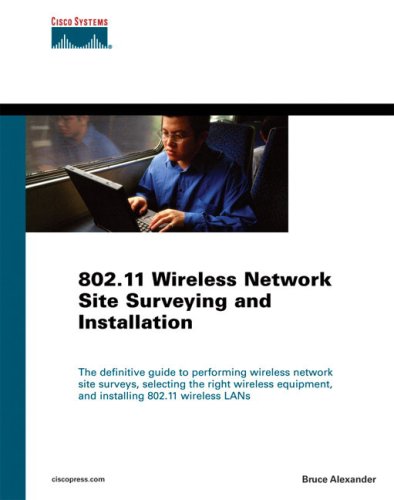Guy Davies9780470867396, 0470867396
Table of contents :
Team DDU……Page 1
Contents……Page 8
List of Figures……Page 14
List of Tables……Page 16
About the Author……Page 18
Acknowledgements……Page 20
Abbreviations……Page 22
Introduction……Page 28
1 Hardware Design……Page 36
1.2 Building Blocks……Page 37
1.2.4 Stateful Failover……Page 38
1.3 To Flow or Not to Flow?……Page 39
1.4 Hardware Redundancy, Single Chassis or Multi Chassis……Page 40
2.1 Maximum Transmission Unit (MTU)……Page 42
2.1.2 Port Density……Page 43
2.2 Ethernet……Page 44
2.2.1 Address Resolution Protocol (ARP)……Page 45
2.3 Asynchronous Transfer Mode (ATM)……Page 46
2.5 SRP/RPR and DPT……Page 48
2.5.1 Intelligent Protection Switching……Page 50
2.6 (Fractional) E1/T1/E3/T3……Page 51
2.7.3 Obstructions……Page 52
2.7.5 If it is so bad . . …….Page 53
3.1 The Importance of an Out-Of-Band (OOB) Network……Page 56
3.1.3 Auxiliary (Aux) Port……Page 57
3.2 Network Time Protocol (NTP)……Page 58
3.4 Simple Network Management Protocol (SNMP)……Page 59
3.4.1 SNMPv1, v2c and v3……Page 60
3.6.1 CiscoWorks……Page 61
3.7.1 Concurrent Version System (CVS)……Page 62
3.7.2 Scripting and Other Automated Con.guration Distribution and Storage Mechanisms……Page 63
3.8 To Upgrade or Not to Upgrade……Page 66
3.9 Capacity Planning Techniques……Page 67
4.1 Securing Access to Your Network Devices……Page 70
4.1.2 Authentication, Authorization and Accounting (AAA)……Page 71
4.2.2 Encryption of Information……Page 75
4.2.3 Access Tools and Protocols……Page 76
4.2.4 IP Security (IPsec)……Page 78
4.2.5 Access Control Lists……Page 79
4.2.6 RFC 1918 Addresses……Page 80
4.2.7 Preventing and Tracing Denial of Service (DoS) Attacks……Page 81
4.3 Protecting Your Own and Others’ Network Devices……Page 82
5 Routing Protocols……Page 84
5.2 Interior Gateway Protocols (IGP)……Page 85
5.2.1 Open Shortest Path First (OSPF)……Page 86
5.2.2 Authentication of OSPF……Page 88
5.2.3 Stub Areas, Not So Stubby Areas (NSSA) and Totally Stubby Areas……Page 89
5.2.4 OSPF Graceful Restart……Page 90
5.2.6 Intermediate System to Intermediate System (IS-IS)……Page 91
5.2.7 Authentication of IS-IS……Page 92
5.2.9 Routing Information Protocol (RIP)……Page 93
5.2.10 Interior Gateway Routing Protocol (IGRP) and Enhanced Interior Gateway Routing Protocol (EIGRP)……Page 94
5.2.11 Diffusing Update Algorithm (DUAL)……Page 96
5.2.13 Why use EIGRP?……Page 97
5.3.1 Border Gateway Protocol (BGP)……Page 98
5.3.2 Authentication of BGP……Page 102
5.3.3 BGP Graceful Restart……Page 103
5.3.4 Multiprotocol BGP……Page 104
6.1 What is Policy For?……Page 106
6.2 Implementing Scalable Routing Policies……Page 107
6.3.2 The Flow of Policy Evaluation……Page 108
6.5.2 Accept/Permit, Reject/Deny, and Discard……Page 109
6.8 Pre.x Lists and Route Lists……Page 110
6.9 Internet Routing Registries……Page 112
6.10 Communities……Page 113
6.12 Local Preference……Page 115
6.13 Damping……Page 116
6.14 Unicast Reverse Path Forwarding……Page 118
6.16.1 Policy Recommendations for Customer Connections……Page 119
6.16.3 Policy Recommendations for Transit Connections……Page 120
6.17 Side Effects of Policy……Page 126
7 Multiprotocol Label Switching (MPLS)……Page 132
7.1 Traf.c Engineering……Page 133
7.2 Label Distribution Protocols……Page 134
7.4 Label Distribution Protocol (LDP)……Page 135
7.5 RSVP with Traf.c Engineering Extensions (RSVP-TE)……Page 136
7.5.3 IS-IS with Traf.c Engineering Extensions (IS-IS-TE)……Page 137
7.6 Fast Reroute……Page 138
7.7 Integrating ATM and IP Networks……Page 139
7.8 Generalized MPLS (GMPLS)……Page 140
8.1.1 Layer 3 VPN (RFC 2547bis)……Page 144
8.1.2 Generic Router Encapsulation (GRE)……Page 146
8.2.1 Circuit Cross-Connect (CCC)……Page 147
8.2.3 Martini (Layer 2 circuits)……Page 148
8.2.4 Virtual Private Wire Service (VPWS)……Page 149
8.2.5 Virtual Private LAN Service (VPLS)……Page 151
8.2.6 Layer 2 Tunnelling Protocol (L2TP)……Page 152
9.1 Design and Architectural Issues of CoS/QoS……Page 154
9.2.1 Classi.cation……Page 155
9.2.2 Congestion Noti.cation Mechanisms……Page 156
9.2.3 Congestion Avoidance Mechanisms……Page 157
9.2.4 Queueing Strategies……Page 159
9.3 QoS Marking Mechanisms……Page 162
9.3.1 Layer 2 Marking……Page 163
9.3.2 Layer 3 QoS……Page 164
9.4 Integrating QoS at Layer 2, in IP and in MPLS……Page 165
9.4.1 DiffServ Integration with MPLS……Page 166
10.1 Multicast Forwarding at Layer 2……Page 168
10.1.2 Multicast Over Token Ring……Page 169
10.1.3 Internet Group Management Protocol (IGMP)……Page 170
10.1.5 PIM/DVMRP Snooping……Page 171
10.1.7 Cisco Group Management Protocol (CGMP)……Page 172
10.2.2 Dense Mode Protocols……Page 173
10.2.3 Sparse Mode Protocols……Page 178
10.2.4 Multicast Source Discovery Protocol (MSDP)……Page 183
10.2.6 Multicast Scoping……Page 184
11.1 Evolution and Revolution……Page 188
11.3 IPv6 Addressing……Page 189
11.3.1 Hierarchical Allocations……Page 190
11.3.2 Address Classes……Page 192
11.5 Domain Name System (DNS)……Page 193
11.6.2 Network Address Translation-Protocol Translation……Page 194
11.6.3 Tunnelling IPv6 in IPv4……Page 195
11.7.3 RIPng……Page 196
11.9 IPv6 Security……Page 197
11.10 Mobility in IPv6……Page 198
12 Complete Example Con.guration Files (IOS and JUNOS Software)……Page 200
12.1 Core Router (P) Running MPLS TE Supporting LDP Tunnelled Through RSVP-TE, No Edge Interfaces, iBGP Only, Multicast RP (Anycast Static) MSDP, PIM-SM (JUNOS)……Page 201
12.2 Core Router (P) Running MPLS TE Supporting LDP Tunnelled Through RSVP-TE, No Edge Interfaces, iBGP Only, Multicast RP (Anycast Static) MSDP, PIM-SM (IOS)……Page 218
12.3 Aggregation Router (PE) Running MPLS L3 and L2VPN Over LDP, BGP Policy to Customers, MBGP, PIM-SM (JUNOS)……Page 227
12.4 Aggregation Router (PE) Running MPLS L3 and L2VPN Over LDP, BGP Policy to Customers, MBGP, PIM-SM (IOS)……Page 248
12.5 Border Router Running MPLS with LDP, BGP Policy to Peers, MBGP,PIM-SM (JUNOS)……Page 257
12.6 Border Router Running MPLS with LDP, BGP Policy to Peers, MBGP,PIM-SM (IOS)……Page 271
12.7 Transit Router Running MPLS with LDP, BGP Policy to Upstream Transit Providers, MBGP, PIM-SM (JUNOS)……Page 277
12.8 Transit Router Running MPLS with LDP, BGP Policy to Upstream Transit Providers, MBGP, PIM-SM (IOS)……Page 292
References……Page 298
Index……Page 300







Reviews
There are no reviews yet.